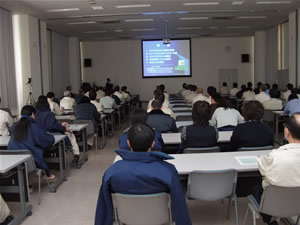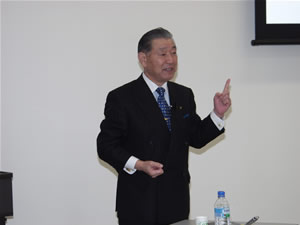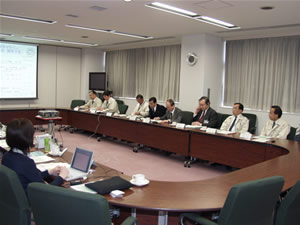|
|
 |
|
On 21, December 2007, the 101st Safety Caravan session was conducted at the Yokosuka area, Central Research Institute of Electric Power Industry Yokosuka-city, Kanagawa Prefecutre. |
| Safety Presentation |

|
|
During the Safety Presentation
|
About 60 persons, including the employees of Central Research Institute of Electric Power Industry, attended the Safety Presentation.
The presentation began with opening remarks from Mr. M. Sato, Director of the Yokosuka Operation & Service Center, who spoke about the following.
CRIEPI has three research laboratories in the Yokosuka area where diversified research is carried out using high voltage, large volume electric current, high pressure gases, chemicals, and so on. It goes without saying that many dangers and hazards lurk there. And for that very reason, all sorts of safety management activities are promoted in our laboratories at study meetings within each experiment group in dealing with the assurance of safety of equipment and the drawing up of operation procedure manuals and the handling of chemicals, pre-equipment installation safety investigative commissions, safety and health committees, etc., with every single individual (including contractors) as well as the overall organization on the whole endeavoring to ensure safety.
Nevertheless, any thoughts of "this is good enough" are forbidden when it comes to safety management. Even though not leading to a major accident, every year there are near-miss situations reported, and thus we have got to make all the more efforts in safety management. Today we have the good fortune of being able to receive valuable information from specialists from outside our own organization, which I am certain will certainly prove useful hereafter in the safety management activities in our Yokosuka laboratories.
After the opening remarks, Mr. Akira Ishibashi, Director of the Research and Development Section of the Japan Institute of Human Factors gave a presentation titled "Considering human factors and safety." |
Lecture highlights |

|
|
Mr. Akira Ishibashi,
Director of the Research and Development Section
of the Japan Institute of Human Factors
|
◆ At the presentation, Mr. Ishibashi brought up some very valuable points, including the following.
◆ The organizational arrangement of activities at the CRIEPI Yokosuka research laboratory facilities is rather flat, and we are always taking on new challenges. In terms of the Rasmussen SRK model, we are continuously promoting knowledge base activities on a regular basis. There are no precedents, no rules, no checklists. In order to maintain safety under these conditions, the advancement of risk assessment activities at all times is indispensable.
◆ Considering safety from the human factor point of view, we need to alter the course of safety techniques from the legacy tombstone safety to preventive safety. There have been hardly any major accidents or accidents resulting in injury or death at the Yokosuka facilities, but there is a history of minor accidents. Under the conventional tombstone safety in which a lesson is learned when a certain type of accident occurs and then recurrence is prevented, this tells us that safety as such is not being maintained. We need to develop preventive safety techniques in order to prevent accidents through sensitive detection of perils that lurk among everyday tasks. In concrete terms, such endeavors are "risk assessment."
◆ Taking a look at traffic accidents that have occurred up until now as the primary examples of industrial accidents, we notice that accidents having similar causes occur again and again. This is proof that the indirect causes behind the direct causes of the accidents were not pursued and effective recurrence measures were not worked out. What we need to do is to conduct detailed investigations of accident precedents from the human factor point of view and create effective countermeasures. To accomplish this, we need to have an accurate understanding of the human factor. In the airline world also, endeavors that actively pursue the human factor have been commonplace since long ago, and are incorporated into safety management systems.
◆ Safety management systems are constructed by putting risk assessment activities together from this sort of perspective. For this, there needs to be a foundation of safety culture. True safety culture is when the organization on the whole understands the importance of safety, and reacts spontaneously to the situation. We have to build a risk assessment system based on the concept of "it is too late after an accident has already occurred."
Comments from the questionnaires conducted after the presentation:
● The systematic and rational lecture was extremely informative. Research and experiments can be done over again, and rehearsal is possible, but in the preservation of safety, there is no second chance. In the past, I felt the pressure of ensuring safety at the work site, but my actual awareness of safety was somewhat vague. The suggestion that the human brain (processing of information) is a mono-channel process left an impression on me.
● As one who conducts experiments regularly, I do my best to attend to safety more than most people, and so I was very much interested in today's theme of the human factor and safety. The lecture was short and yet easy to understand, and it made me feel that the cultivation of safety culture is highly important.
● I believe that safety is a profound and perpetual task, and I will try to attain a consciousness toward building up safety culture.
● The lecturer explained in a very easy to understand way about risk management including related . I am very glad to have been able to attend this lecture today. We frequently discuss risk management within our laboratories, and I intend to put the ideas explained today into use hereafter.
● I was able to understand quite well about safety culture. I came to understand the need for a balance between "top down" and "bottom up," and if one is predominant over the other, the target can not be reached. Also, since the creation of an atmosphere in which this can be put into practice eventually leads to giving strength to both the "individual" and the "organization," I believe that "incentives" play a role in promoting "safety culture."
● Thank you for the easy to understand talk on the way of thinking about safety culture. I have always aspired to pay close attention to safety in my routine daily work, but through the culture of the organization taking root, I furthermore, I realized again the safety with own circumference improved. And so, the discussion about changing our way of thinking in regard to reporting errors was quite an awakening to me.
● Thank you for the very easy to understand lecture. I look forward to today's talk being useful hereafter in the creation of a safety culture environment. I came to realize that it is important to have a climate of learning lessons from errors without punishing.
These and other opinions and impressions were expressed in the questionnaires.
Afterward, Hamada, Planning Group Leader of NSnet Division, Japan Nuclear Technology Institute presented an overview of the activities of our organization. |
Safety information exchange session |

|
|
During the Safety information exchange session
|
At the request of the Central Research Institute of Electric Power Industries, Mr. Norio Nomura, Section Chief of Safety Administration Section, Oarai Research and Development Center of the Japan Atomic Energy Agency (JAEA) was present at the safety information exchange session and gave a detailed explanation of "the risk assessment endeavors at JAEA Oarai Research and Development Center."
After these talks, opinions were exchanged on the above-mentioned endeavors. |
|
|







